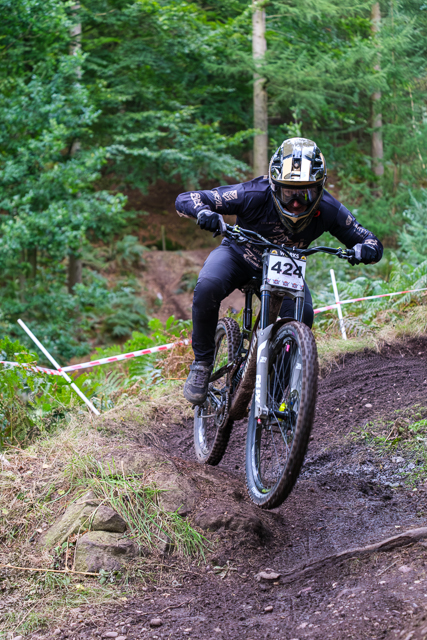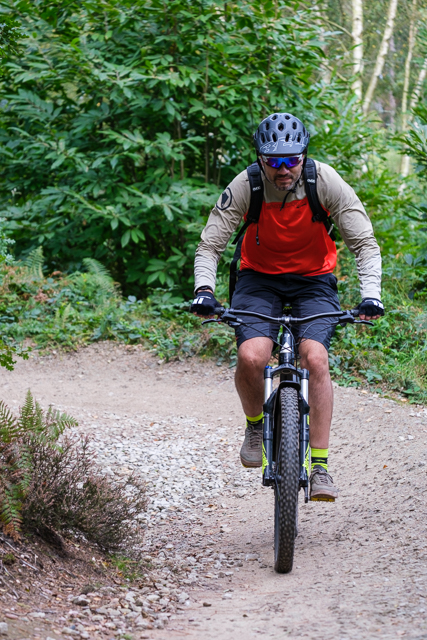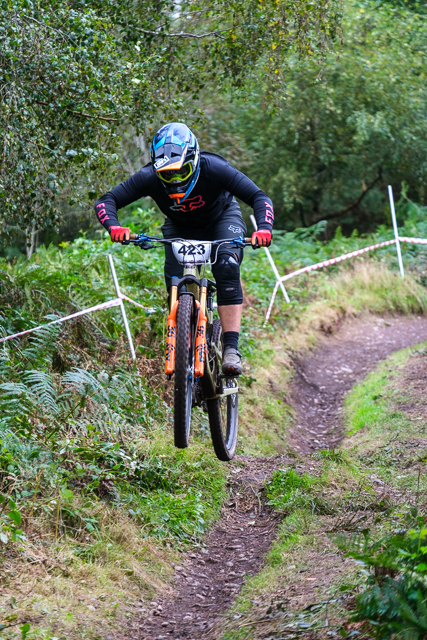
When I switched camera systems to Fuji back in 2018 I thought that my sports photography days were in the past. However, I really enjoyed photographing the British Downhill Series at Llangollen last year, and a few other mountain bike races since. The only problem was that I felt I was being held back by the autofocus on my Fuji X-T2. When Fuji launched the X-H2S camera with a stacked 26 Megapixel sensor and improved autofocus my interest was piqued. Especially as they announced it with a mountain bike video! I did have some reservations, as the camera was aimed at hybrid (stills and video) shooters and hoped that Fuji would have carried over the new technology to the next X-T camera aimed at photographers. Instead, they went for a higher resolution, 40 Megapixel, sensor. My ideal camera would have been the sensor from the X-H2S, in the body of the X-T5, but sadly Fuji have not made that (yet!), so I have to choose between the high resolution stills model, or the fast hybrid camera. Luckily Fuji UK free 48 hour test drives, so I would be able to try both options. I decided to test the X-H2S first and booked the loan in to coincide with the first round of the Racers Guild Winter Series Downhill race at Cannock Chase.

My first reaction on unpacking the camera was that it is a chonky beast – I had not appreciated how much bigger it would be than my X-T2. After failing to attach the supplied strap, I threw on some Peak Design tethers, so I could use my Peak Design Slide strap. The strap lugs on the X-H2S are much better than on the X-T bodies which require metal rings between the camera and strap (or anchor in my case), it is only a minor point, but one that made me warm to the X-H2S. On my lunch break, I quickly dialled in some settings, and went for a walk in my local woods, to try and test the autofocus on some squirrels. I did not have much time, nor were the squirrels cooperating, but I did get a glimpse of what the subject detect autofocus was like. However the first real test was in the evening when Owen was at his karate dojo – Henry and I went to a nearby park. Henry was typically reluctant for photos, but I managed to grab a few shots with my 35mm f1.4 prime lens fitted to the X-H2S. This lens is known to be slow to focus, so I could not come to any conclsions about that, but chasing Henry around the play ground was a good test for the handling of the camera – such as quickly switching to a slow shutter speed for the photo on the roundabout. Upon getting the files in to Lightroom I really liked the Nostalgic Negative film simulation, which is not available on my previous generation Fuji cameras.
The race was on Sunday, but we also had a fun plan for the Saturday – Owen and I were going on a boys mountain bike trip with my friend Partho. The original plan had been a trip to one of the “top ten XC trails” with Partho, which was one of my goals for the year. However, Owen needed to come with us, so it changed to a boys trip to the Forest of Dean to keep the driving time down. Then we realised that there was a big event on there, and plan C formed – a return visit to Sherwood Pines for Owen to try and meet his goal of a 20km bike ride.

We rode the full length of the red-graded “Outlaw” trail, which was not quite long enough for Owen to meet his goal, so we added on another short loop, starting on the blue-graded “Maid Marian” trail, then rejoining the last few sections on the “Outlaw” trail. Before heading out for the second loop, I swapped my hydration pack for my camera bag, to get some shots of Owen and Partho on a new section of the blue trail. I chose a berm, with good lighting, set the X-H2S to 15 frames per second high speed shutter, activated the “bicycle” AI focus mode and called for Owen, and then Partho to drop in. I felt like I got good shots of them both railing the berm, then quickly packed up my bag and chased them down the trail. It felt great to be riding at my pace on a fun section of trail, even if I had a heavy camera bag on my back. As I caught up with the others Partho even managed to get a photo of me airborne over a jump.
We completed the loop, and celebrated Owen achieving his goal with some lovely brownies that Partho had brought with him. The excitement only lasted until we were back at home and I had downloaded the images to Lightroom: none of the eleven frames of Owen were sharp, and only one out of seven of Partho were sharp – the one above. The shutter speed, 1/500th of a second, should have been fast enough, so it could only have been missed focus. Disappointing when I had such high expectations for the autofocus on the X-H2S.
Not feeling fully convinced with the autofocus on the X-H2S, I decided to also take my X-T2 with me to Cannock Chase, just in case it was needed (thankfully, it wasn’t). After walking down the track I found a good corner to shoot from, but again, the AI autofocus was struggling, so I started going back up the track to try a few more angles. For the last few runs of practice I was shooting head on, as the riders came down a long chute – and the AI autofocus was working well. It seemed that it needed to see the rider for a bit before tracking then – maybe this is something that I could have tweaked in the advanced settings, but would need more time with the camera to be sure. Another option would have been to disable the subject detection autofocus and to just use a single focus point, like I would have done on the X-T2, but in the heat of the moment I did not consider that option.

Now knowing how to play to the camera’s strengths, I stayed at the bottom of the chute for the first race runs. The photos were nicely in focus, and I had been able to get a shot of most of the riders. However, they were not what I was hoping for, they were lacking in dynamism, execept for the riders that were jumping.

For the second race, I went back to the first corner I had scoped out. I had come up with a plan to work around the autofocus limitations I had experienced earlier – I would switch the camera to manual focus (I missed the SCM focus switch from the more traditional Fujis) and pre-focus on the exit of the corner. The 15 frames per second burst mode would allow me to pick the sharpest frame. As well as being better for photography, there was more of a party atmosphere at this corner, as it was towards the end of the track, next to the biggest drop. Riders were finishing their runs and gathering around this area to watch the faster racers coming down on their runs. Once again I was reminded just how fun it is to watch mountain bike racing in person, even at a grassroots level, the fact that I was able to photograph it was the icing on the cake!
When I got home, I had some issues importing the files to Lightroom, I do not know if this was a hardware or software issue on my MacBook Pro, or anything to do with the Cfexpress Type B card used in the X-H2s. I tired importing both from the card reader Fuji had sent with the camera, and by connecting the camera directly by USB, but both had issues. It is something that I would need to investigate more in the future, but I would not rule out the camera based on this. As I understand it, the Cfexpress Type B card is part of the reason that then camera is so fast in use, but I thought that it was worth noting the import issues. Otherwise, I was happy with the image quality, it is the quality I would expect from a Fuji X camera.
My preconceptions of the X-H2S were that I would love the autofocus, but hate the handling, I was wrong on both counts. I was underwhelmed by the autofocus, although I expect that with more time, tweaking of the settings and learning how to work with the camera I would be happier with it. Experienced camera reviewers believe that the autofocus on this model is pretty much on a par with Canon and Sony’s high end cameras, so will have to trust them on that. After initially thinking that the camera was huge, I grew to appreciate the size and handling – I even managed to forget to take a camera strap with me to the bike race, so held the camera all day – I am not sure that would have been as doable with my X-T2, which is a much smaller body. I was shooting in shutter priority mode all weekend, but adapted to the different “PASM” controls easily – I thought this would be a deal breaker for me, but I think I could manage.
Although I am yet to try the X-T5, the X-H2S has overtaken it and is now top of my wish list for my next camera. However the reason I use wish list is that there is a big price jump from the X-T5, especially when you consider the need for a Cfexpress Type B card and that there is no “kit” package with the 16-80f4 lens available for the X-H2S. However, my main takeaway from the weekend is that I probably need to prioritise a new telephoto lens, rather than a new camera body. When I bought my Fuji 55-200mm lens I liked the compact size and versatility, but after a few years I am coming into its limitations – the autofocus could be better and I either use it at the wider end or maxed out at 200mm for wildlife, where it is not really long enough. So an upgrade to the Fuji 50-140mm f2.8 lens is in order, and my aspirations for wildlife photography will have to be put on hold. 50-140mm is the Fuji equivalent of the 70-200mm lens that I used on Canon for many years and is the go to focal length for sports photography. So even though my expectations for the weekend went out of the window, I still feel like I have come out of it with some clarity on what camera kit I will purchase next.